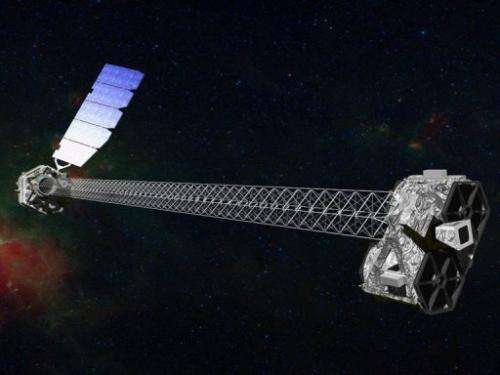NASA poised to launch 'black hole hunter' (Update)

NASA is poised to launch on Wednesday a sophisticated orbiting telescope that uses high-energy X-ray vision to hunt for black holes in the universe.
The Nuclear Spectroscopic Telescope Array (NuSTAR) will first be carried into the skies by a jet which will deploy a rocket that sends the satellite into space, NASA said.
"Why launch from the air? Plane-assisted launches are less expensive than those that take place from the ground. Less fuel is needed to boost cargo away from the pull of Earth's gravity," the US space agency said in a statement.
The project aims to study energetic phenomena such as black holes and the explosions of massive stars.
Orbital Sciences Corporation designed and manufactured the telescope and will send it into orbit from its own Pegasus air-launched rocket, which is attached to the underside of the company's L-1011 Stargazer aircraft.
The jet will take off from Kwajalein Atoll in the Marshall Islands about an hour before the four-hour launch window opens at 11:30 am Eastern (1530 GMT). Weather was 99 percent favorable for the launch, NASA said.
The aircraft is scheduled to drop the Pegasus rocket 117 nautical miles south of Kwajalein, at an altitude of 39,000 feet over the Pacific Ocean, quite close to the equator.
The spacecraft should separate from the rocket 13 minutes later.
"NuSTAR will open a whole new window on the universe," said Fiona Harrison, who is a professor at the California Institute of Technology in Pasadena and is the principal investigator on NuSTAR.
It will be the "first telescope to focus high energy X-rays. As such it will make images that are 10 times crisper and 100 times more sensitive than any telescope that has operated in this region of the spectrum."
The mission aims to work in concert with other telescopes in space, including NASA's Chandra X-ray Observatory, which observes lower-energy X-rays, NASA said.
NuSTAR is more potent than its predecessors because of the way it focuses high-energy X-ray light by using nested shells of mirrors to prevent the light from reflecting off.
With 133 nested mirrors in each of two optical units, the telescope also uses state-of-the-art detectors and a long mast that connects the optical units to the detectors and allows enough distance for a sharp focus.
The 33-foot (10-meter) mast will launch in a folded-up position but will extend about a week after launch, bringing it to about the length of a school bus.
"It used to be thought that black holes were rare and exotic -- that was just 20 years ago," Harrison told reporters.
"Today we know that every massive galaxy, like our Milky Way, has a massive black hole at its heart."
The new observatory aims to give a better view of the workings of a black hole, since the dust and gas that gets sucked into the gravity of a black hole becomes quite hot from speed and friction created as it circulates around the edge.
Paul Hertz, NASA's Astrophysics Division director, described NuSTAR as "a small space telescope that will provide world-class science in an important but relatively unexplored band of the electromagnetic spectrum."
(c) 2012 AFP





















